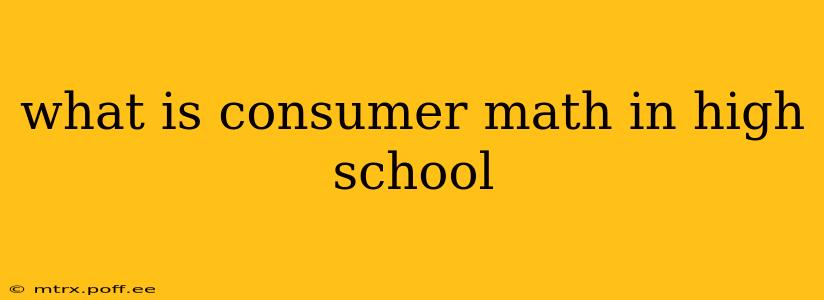Consumer math, also known as applied mathematics or practical math, is a high school course designed to equip students with the essential mathematical skills needed to navigate everyday financial situations. Unlike traditional algebra or geometry, consumer math focuses on real-world applications, preparing students for responsible financial decision-making throughout their lives. This course emphasizes practical problem-solving rather than abstract theoretical concepts.
What topics are covered in a consumer math class?
The curriculum typically covers a wide range of financial topics, including but not limited to:
-
Budgeting and Financial Planning: Students learn to create and manage personal budgets, track income and expenses, and plan for short-term and long-term financial goals. This often involves learning about different budgeting methods, like the 50/30/20 rule.
-
Banking and Credit: This section delves into understanding different types of bank accounts, checking accounts, savings accounts, interest calculations (simple and compound), credit cards, credit scores, and the implications of debt. Students learn about APR (Annual Percentage Rate), credit card fees, and the importance of maintaining a good credit history.
-
Shopping and Comparison Shopping: Students develop skills in comparing prices, calculating discounts (percentage discounts, sale prices), understanding sales tax, and making informed purchasing decisions. This often involves learning about unit pricing and evaluating the best value for money.
-
Loans and Mortgages: The course explores different types of loans, including installment loans, auto loans, and mortgages. Students learn how to calculate loan payments, understand interest rates, and compare loan offers. The concept of amortization is often introduced.
-
Taxes: Students gain a basic understanding of income tax, sales tax, and property tax. They may learn about tax forms and deductions.
-
Investing: A basic introduction to investing is often included, covering topics like stocks, bonds, mutual funds, and the importance of diversification. Risk and return are key concepts explored here.
-
Insurance: Students learn about different types of insurance, including health, auto, and homeowner's insurance. They explore concepts like premiums, deductibles, and coverage.
What are the benefits of taking a consumer math class?
Taking a consumer math course offers several significant benefits:
-
Improved Financial Literacy: The course directly improves students' understanding of personal finance, empowering them to make informed financial decisions.
-
Enhanced Problem-Solving Skills: The focus on real-world applications strengthens problem-solving abilities in a practical context.
-
Increased Confidence in Handling Finances: Students gain confidence in managing their money and avoiding common financial pitfalls.
-
Better Preparedness for Adult Life: The skills learned are directly transferable to adult life, fostering responsible financial behavior.
-
Foundation for Further Study: The course can serve as a foundation for further studies in finance, accounting, or economics.
What is the difference between consumer math and algebra?
While both are branches of mathematics, consumer math and algebra differ significantly in their focus and application. Algebra emphasizes abstract concepts, equations, and symbolic manipulation, while consumer math focuses on practical applications of mathematical principles to everyday financial situations. Algebra is a prerequisite for many higher-level math courses, while consumer math is designed to be a standalone course focusing on real-world relevance.
Is consumer math hard?
The difficulty level of consumer math varies depending on the student's prior mathematical skills and learning style. However, it's generally considered less challenging than algebra or geometry because it emphasizes practical application over abstract concepts. The course is often designed to be accessible to a wide range of students.
How is consumer math assessed?
Assessment methods typically include a variety of approaches to gauge student understanding, such as:
- Homework assignments: Practicing real-world financial problem sets.
- Quizzes: Regular checks for understanding of key concepts.
- Tests: Comprehensive assessments covering multiple topics.
- Projects: Real-world application projects, such as creating a personal budget or comparing loan options.
Consumer math is a valuable course for all high school students, equipping them with the crucial skills necessary for navigating the financial complexities of adulthood. By understanding budgeting, saving, investing, and borrowing responsibly, students can make informed decisions that will positively impact their future financial well-being.
